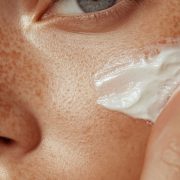Unveil Your Skin’s True Potential: Navigating the World of Chemical Exfoliants
Posted on September 26, 2024 Written by: 100% PURE®

The Exfoliation Dilemma
We all crave clearer, smoother, and more radiant skin. But when it comes to achieving that glowing complexion, navigating the world of skincare can feel overwhelming—especially when faced with a variety of chemical exfoliants promising to transform your skin. Glycolic acid and salicylic acid, two popular options, often leave us wondering which one holds the key to addressing our specific concerns.
The confusion is understandable. While both acids work to rejuvenate the skin, they do so in different ways. How can you be sure you’re choosing the right one for your skin’s needs?
In this article, we’ll demystify the world of chemical exfoliants, break down the differences between glycolic and salicylic acid, and help you decide which one is the best fit for your skincare routine. Plus, we’ll explore the top products containing these powerhouse ingredients.
Demystifying Chemical Exfoliants
When it comes to achieving that luminous glow, exfoliation plays a key role. But not all exfoliants are created equal. While physical exfoliants—like scrubs—use tiny particles to manually slough away dead skin, chemical exfoliants rely on the power of acids to do the job in a gentler, more effective way.
Chemical exfoliants work by breaking down the bonds that hold dead skin cells together, allowing them to shed naturally. Unlike physical exfoliants, which can sometimes cause irritation or microtears, these acids dive deeper into the skin to encourage cell turnover from within. This process is essential to maintaining a smooth, youthful complexion.
Skin naturally renews itself through a process known as cell turnover, where dead cells rise to the surface and are replaced by fresh, new ones. However, this process can slow down with age, leading to dullness, clogged pores, and uneven texture. Chemical exfoliants like glycolic and salicylic acid step in to enhance this process, helping to reveal the glowing, healthy skin underneath.
Understanding how these acids work to promote skin renewal is the first step in choosing the right one for your routine. In the next section, we’ll dive into the specific benefits of glycolic and salicylic acid, so you can confidently select the best exfoliant for your unique skin type.
PHOTO
Understanding Glycolic Acid
Glycolic acid is a member of the alpha hydroxy acid (AHA) family, a group of water-soluble acids derived from fruits and other natural sources. What sets glycolic acid apart from its AHA counterparts is its incredibly small molecular size. This allows it to penetrate the skin more easily and deeply, making it a powerful tool in surface-level exfoliation and skin rejuvenation.
The benefits of glycolic acid are numerous. As it gently dissolves the bonds between dead skin cells, it helps reveal a smoother, brighter complexion. Beyond exfoliation, glycolic acid has hydrating properties and can stimulate collagen production, which is crucial for maintaining the skin’s elasticity and youthful appearance.
For those with dull, aging, or sun-damaged skin, glycolic acid is an ideal solution. It helps address hyperpigmentation, fine lines, and uneven texture, leaving skin looking refreshed and renewed.
But is glycolic acid right for you? In the next section, we’ll explore how it compares to salicylic acid, so you can make an informed decision based on your skin type and specific concerns.
Salicylic Acid Explored
Salicylic acid belongs to the beta hydroxy acid (BHA) family and offers a unique advantage in skincare: it’s oil-soluble. Unlike glycolic acid, which is water-based, salicylic acid is able to penetrate deep into the pores, breaking down the oil, dirt, and dead skin cells that can lead to clogged pores and acne.
This oil-soluble property makes salicylic acid highly effective at deep pore cleansing. It doesn’t just exfoliate the surface of the skin—it works within the pores to clear out debris and reduce excess oil. Additionally, it has anti-inflammatory effects, making it ideal for calming active breakouts and reducing redness associated with acne.
Salicylic acid is best suited for those with oily and acne-prone skin. If you struggle with blackheads, enlarged pores, or frequent breakouts, salicylic acid can be your go-to for keeping skin clear and balanced.
But how does it measure up to glycolic acid? Next, we’ll compare the two so you can confidently choose the best option for your specific skin type and concerns.
Choosing Between Acids
When it comes to choosing between glycolic and salicylic acid, many people find themselves confused by misconceptions about chemical exfoliants. One common myth is that these acids are too harsh for regular use. However, when used correctly, both glycolic and salicylic acid can be effective without causing irritation. The key lies in understanding your skin’s needs and using the right concentration.
That said, it’s important to be mindful of potential side effects. Overusing either acid or using concentrations that are too strong for your skin can lead to dryness, redness, or irritation. This is especially true if you have sensitive skin or are new to chemical exfoliants. It’s always wise to start slowly and allow your skin to adjust.
The real challenge is identifying which acid is best for your skin. Glycolic acid is a great choice for those targeting surface-level issues like dullness and fine lines, while salicylic acid excels at deep pore cleansing and managing acne. By understanding these differences, you can avoid common skincare pitfalls and choose the exfoliant that will deliver the best results for your skin type.
The Exfoliation Solution: Incorporating Acids into Your Routine
Incorporating glycolic and salicylic acids into your skincare routine can be transformative when done correctly. But knowing how to use them without overwhelming your skin is key to getting the most out of these powerhouse exfoliants.
How to Use Glycolic Acid
Glycolic acid comes in a variety of concentrations, typically ranging from 5% to 10% in over-the-counter products. If you’re new to glycolic acid, start with a lower concentration and use it two to three times a week. As your skin builds tolerance, you can gradually increase frequency. Glycolic acid can be layered with hydrating products like hyaluronic acid or gentle moisturizers to prevent dryness, but avoid combining it with strong actives like retinol or vitamin C in the same routine, as this can cause irritation.
How to Use Salicylic Acid
Salicylic acid offers flexibility, especially for those dealing with acne. It can be used as an overall treatment or as a targeted spot treatment. For daily use, opt for a cleanser or toner containing 1-2% salicylic acid to help control oil production and prevent breakouts. When combining it with other products, be cautious with exfoliants or harsh cleansers to avoid stripping your skin’s natural moisture barrier.
Potential Combinations and Alternating Use
Some people may benefit from using both glycolic and salicylic acid, especially if they have combination skin. For example, you might use glycolic acid a few times a week to brighten and smooth the skin’s surface, while applying salicylic acid in targeted areas to keep pores clear. Alternating these acids throughout the week ensures you get the benefits without risking over-exfoliation.
When to Use Both Acids
If your skin can tolerate both acids, introducing them into your routine gradually is essential. Start by using each acid on alternate days or nights, and be sure to keep your skin well-moisturized to prevent irritation. With patience and consistency, you can unlock the benefits of both acids while maintaining a healthy skin barrier.
By carefully introducing these exfoliants into your routine, you’ll enhance your skin’s renewal process, address multiple concerns, and achieve that coveted radiant glow.
PHOTO
100% PURE Products with Glycolic or Salicylic Acid
When it comes to choosing the right exfoliant, having effective products is essential. 100% PURE offers several standout options that harness the power of both glycolic and salicylic acids, designed to address different skin needs without compromising on natural ingredients.
This gentle resurfacing cleanser is perfect for those looking to brighten and smooth their skin without harshness. With salicylic acid at its core, it works deep within the pores to clear congestion while resurfacing the skin’s texture, leaving you with a brighter, healthier complexion.
Ideal for acne-prone and oily skin, this serum combines fruit acids with glycolic and salicylic acids to target breakouts and minimize pores. It offers a potent, yet non-drying solution for those battling stubborn acne and oily skin concerns, while also promoting skin renewal.
This salicylic-based toner delivers the best of both worlds by combining the exfoliating benefits of both glycolic and salicylic acid. It helps to minimize breakouts, smooth skin texture, and promote comprehensive skin renewal, making it a great option for those needing an all-in-one solution.
For those seeking a more gentle exfoliant, this glycolic acid-based cleanser is perfect for fighting acne without the risk of over-drying. The 7% fruit acids gently dissolve dead skin cells while nourishing the skin, making it a safe and effective choice for maintaining a balanced, clear complexion.
These products are formulated to complement your skincare routine, offering powerful exfoliating benefits while remaining gentle enough for regular use.
Your Path to Exfoliation Mastery
Glycolic and salicylic acid each offer unique benefits that can transform your skin when used correctly. Glycolic acid excels at resurfacing the skin, promoting hydration, and stimulating collagen for a smoother, more radiant complexion. On the other hand, salicylic acid dives deep into the pores, controlling oil and clearing breakouts, making it a go-to for oily and acne-prone skin.
As you embark on your exfoliation journey, it’s important to listen to your skin’s needs. Whether you’re targeting signs of aging or battling stubborn acne, there’s a solution that will work for you. Start slow, build tolerance, and adjust based on how your skin responds.
Ready to take the next step? Begin your personalized exfoliation journey today, and unlock the radiant, healthy skin you’ve been striving for!
Frequently Asked Questions
Can I use Glycolic and Salicylic Acid together in the same routine?
Yes, you can use both glycolic and salicylic acid, but it’s generally recommended to alternate their use rather than applying them together in the same routine. Using both acids simultaneously can increase the risk of irritation, especially if your skin is sensitive. Consider using glycolic acid at night and salicylic acid in the morning, or alternating days to avoid over-exfoliation.
How often should I use chemical exfoliants, and can I overdo it?
How often you use chemical exfoliants depends on your skin type and tolerance. For beginners, it’s best to start with 2-3 times a week and gradually increase if your skin tolerates it well. Overdoing it can lead to irritation, dryness, and even breakouts, so always monitor how your skin reacts and adjust accordingly.
Are there any ingredients I should avoid when using these acids?
Yes, it’s wise to avoid using strong actives like retinoids, benzoyl peroxide, or vitamin C in the same routine as glycolic or salicylic acid. These combinations can lead to excessive irritation or dryness. Pair your exfoliants with hydrating and soothing ingredients like hyaluronic acid or ceramides to balance the skin’s moisture.
Can pregnant women safely use Glycolic or Salicylic Acid?
While glycolic acid in low concentrations (under 10%) is generally considered safe during pregnancy, salicylic acid should be used with caution. Many healthcare professionals recommend avoiding high concentrations of salicylic acid during pregnancy, especially in leave-on treatments. Always consult with your doctor before using these acids while pregnant.
How long does it typically take to see results from chemical exfoliation?
Results can vary, but most people begin to see improvements in skin texture and clarity within 2-4 weeks of consistent use. Deeper benefits, such as reduced hyperpigmentation or fine lines, may take longer, around 6-8 weeks. Be patient, and remember that consistency is key when it comes to chemical exfoliation!




